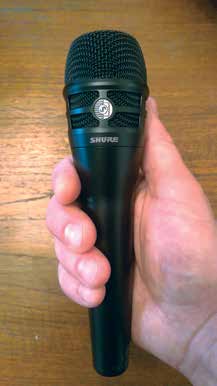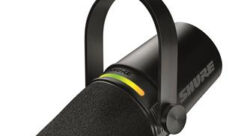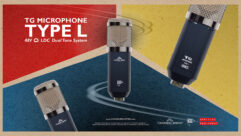

Unveiled with much buzz at the 2016 NAMM Show,
Shure’s KSM8 Dualdyne Microphone
is the company’s first new major dynamic handheld model introduced to market since the Shure SM58 a half-century ago. It is significant in a number of performance-enhancing ways. First, it is indeed “the world’s first handheld dual-diaphragm dynamic,” as claimed in Shure’s promotional materials, ultimately providing greater output levels while lessening proximity effect. As such, this design insures higher gain before feedback (or GBF, most useful in live sound reinforcement) and no need for a builtin “presence peak”—the common midrange frequency “bump” that better balances overall frequency response due to any single diaphragm dynamic’s inevitable low frequency proximity effect boost. In all, the KSM8 is likely a more accurate dynamic handheld than any other on the market; capable of higher SPLs than its single diaphragmed competition; and is predictably built like a tank—road-ready yet beautiful and striking.
In live sound reinforcement applications, the KSM8 performed as advertised and offered much more useful fidelity than I had expected. In one particular five-model lineup amongst traditional dynamics— alongside an Audio-Technica, Electro-Voice, Lewitt and even a ubiquitous Shure microphone—the KSM8 easily stood out, and for good reasons. The setting was a traditional Bluegrass performance in a loud, reverberant room that measured approximately 80 dB SPL with a full audience present. With musicians needing open, wedge-type monitors to hear themselves, the room was literally a roar. The KSM8 easily bested the other dynamics in my use of it, providing an accurate, open and clean-sounding vocal transduction of main vocalist/ archtop mandolinist Lou Reid (Ricky Skaggs, Vince Gill) while avoiding feedback.
Compared to the sculpted frequency responses of traditional dynamic microphones, it took a bit of getting used to working with the “flatter” KSM8; often audio engineers EQ a dynamic microphone in certain ways to overcome or improve these aforementioned sonic characteristics. Working with the KSM8 just doesn’t require this. For example, lows aren’t rolled off and mids aren’t carved up, leaving the KSM8’s performance far more natural sounding—and along the lines of a great, non-hyped condenser. Plus, with no real proximity effect to speak of, performers don’t have to “work” any characteristics of the KSM8 and can pull multiple inches away from the mic with no LF loss, for one example. Of course, this means just a slight adjustment in performance for the experienced/professional dynamic handheld user, but one that’s totally worth it for crystal clear (both figurative and literal) reasons.









